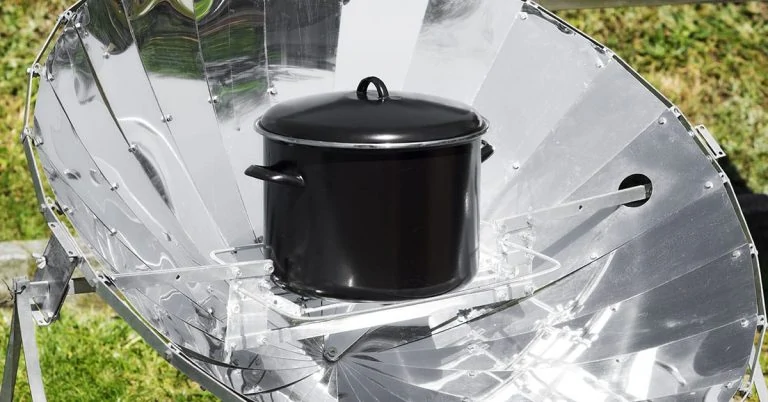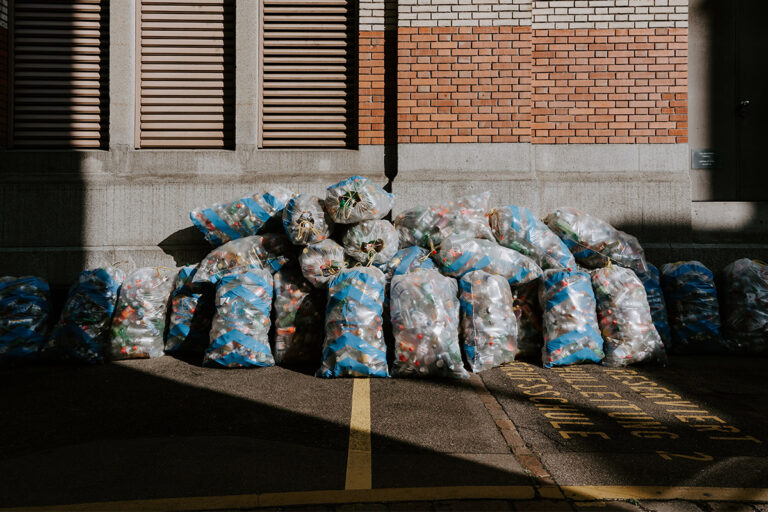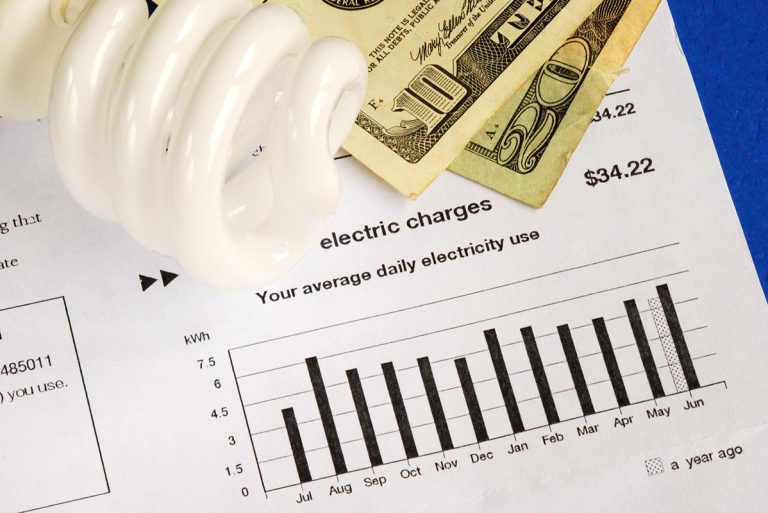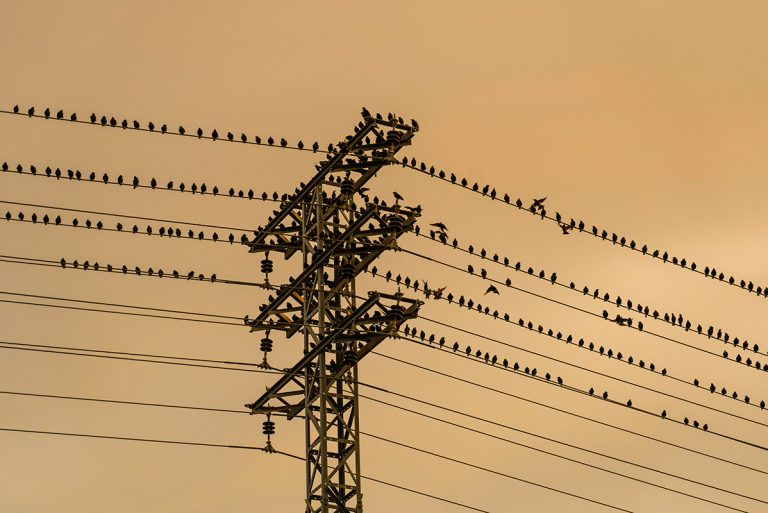Did you feel trapped by air pollution this past summer, unable to catch even a brief breath of fresh air? Maybe you were scared to take a breath outside.
Unfortunately, you weren’t alone.
For the first time in history for many weeks in the Summer of 2021, several places on the East Coast of the United States experienced hazy skies and code orange air quality alerts due to wildfires raging on the West Coast, over 3,000 miles away.
You can track how much wildfire smoke contaminated your local air in the U.S. with this interactive tool.
What made matters worse is that most of the USA was also in the grips of numerous heat waves during the alerts, making it more difficult to breathe. And not just outside.
Residents dealing with the health effects of air pollution created from wildfires on top of the usual urban and industrial smog in a sweltering climate were informed not to use their ACs.
Turns out air conditioners pull in dirty air from the outside during normal functioning, leaving your indoor air unhealthy, too.
Meanwhile, the effects of air pollution on the environment grew exponentially as well. In general, air pollution has negative effects on crop yields, for example. Smoky grapes don’t make for fine wine, either.
Below the harmful impacts of air pollution on human health and the environment runs the ever-present undercurrent of our fossil fuel-driven climate crisis that intensifies most weather events. This means summer temperatures were higher, heatwaves were longer, and fires were more uncontrollable than “normal.”
Tragically, the wildfires are still going strong.
In this wide-ranging article, you will discover key takeaways of the latest research on human health and the environmental effects of air pollution. You’ll also find tips on how you can reduce the harmful effects of air pollution in your home, at work, or in school.
What is air pollution?
Air pollution consists of any airborne substance that causes harm to living beings and the environment. Even “harmless” materials, when present in great enough concentration (quantity in a given space), can be considered air pollutants.
For example, do you recall when former U.S. president G.W. Bush famously stated that carbon dioxide (CO₂) is not a pollutant?
He (sort of) had a point.
In small enough quantities present over a large enough area, CO₂ is not an air pollutant. In fact, plants need carbon dioxide to make food during photosynthesis.
While it’s true that sometimes plants do grow more when surrounded by increased carbon dioxide, researchers have shown that this is not a good thing, all things considered.
Nevertheless, it’s still true to say that CO₂ is not a pollutant to plants — at appropriate concentrations only.
However, when the concentration of carbon dioxide becomes too great — like it is right now at 420 parts per million (ppm) compared to pre-industrial times when it was at 278 ppm — our climate crisis results. So today, there’s no question that a great amount of carbon dioxide added to the atmosphere in a relatively short period of time — geologically speaking — is an air pollutant.

Source: climate.nasa.gov
You can look at carbon dioxide from another perspective, too, and come to the same conclusion.
As a human waste product, there is a certain amount of carbon dioxide in your body. As long as you exhale, it’s not a problem. You wouldn’t call yourself polluted because of it.
Yet, when there’s too much CO₂ in your body, sickness or disease results. In that case, carbon dioxide is a pollutant.
Chemical air pollutants
There are hundreds of thousands of chemicals in existence today. Only a handful have been tested for toxicity. Not all are typically airborne either.
Out of all chemicals, there are only six chemicals that are routinely studied for their harmful effects on human health and the environment. They are regulated by the U.S. Environmental Protection Agency (EPA) under the Clean Air Act. The World Health Organization (WHO) compiles global health and environmental impacts stemming from exposure to most of these.
The dirty six chemicals according to EPA:
- Particulate matter (PM2.5 and PM10)
- Ground level ozone (O₃)
- Nitrogen dioxide (NO₂)
- Sulfur dioxide (SO₂)
- Carbon monoxide (CO)
- Lead
Surprised by the notable absence of carbon dioxide on this list?
Other major greenhouse gases, like methane and hydrofluorocarbon coolants, are not listed either.
The first one on the list, PM, is a catch-all category in which many chemicals of certain sizes fall. Particulate matter (also called particle pollution) is not just a single chemical like all the others on this list.
You’ll learn more about the health and environmental effects of these so-called “criteria” air pollutants in later sections.
There are a plethora of other toxic air pollutants that merit placement on this list because they either are harmful to human health and/or the environment. In this article, you’ll find out about some of them as well.
As a group, these non-listed chemicals are called hazardous air pollutants (HAPs). Many of them cause cancer or birth defects if present in only tiny amounts. They include (followed by common sources):
- Benzene (gasoline)
- Perchloroethylene (dry cleaning)
- Methylene chloride (paint stripper)
- Dioxins (burning wood, coal, trash, fatty foods)
- Asbestos (building materials)
- Heavy metals (fossil fuel-driven power plants)
Even brief exposure to these airborne toxic chemicals can cause chronic health problems, serious injury, or even death.
Sources of air pollution
If you see a pattern here — fossil fuels burned for energy and transport as well as in industry — you’re spot on for the major source of air pollution.
Here are some other ways your air becomes polluted with the dirty six and more:
- Trash incineration
- Toxic household and personal care products
- Home furnishings
- Building construction and demolition
- Farming activities
- Mining precious metals
- Drilling for more fossil fuels

With the exception of a few cases, like volcanic eruptions, almost all air pollution results from human (anthropogenic) activities.
However, even volcanic eruptions need to be reevaluated. Greater frequency of eruptions has been linked to less pressure on the earth due to sea ice melting caused by anthropogenic climate change.
It easily follows from this discussion that changing human behavior can reduce air pollution and its harmful effects on health and the environment.
This is proving to be easier said than done.
Given how much in the last few years our climate crisis has worsened air pollution in terms of wildfires alone, on top of the astronomical economic losses stemming from wildfires, you’d think there would be more willingness to change course and even some governmental initiative toward this end. Sadly, this is not yet the case. (More on this below.)
Major regulatory air pollution standards: United States Clean Air Act
The 1970s heralded the passage of the Clean Air Act (CAA) in the United States. At that time, it was a groundbreaking win for the environment and human health.
Unfortunately, the CAA has been whittled down in force over time. Nor has it undergone necessary updates to keep pace with the growing types, quantities, and sources of air pollution. In fact, the last time this legislation was amended was over 30 years ago.
Under the CAA, the EPA is required to set National Ambient Air Quality Standards (NAAQS) for the six criteria air pollutants listed above. On a regular basis, EPA must determine which areas of the country meet the standards and which regions do not.
After EPA’s designation, states must develop plans to address high pollution levels for all six pollutants on the list so that NAAQS are always met.
The NAAQS apply only to ambient air that the EPA defines as outside air. (Indoor air quality is not at all regulated by the EPA, even though indoor air pollution can be worse than outdoor air.)
There are two types of NAAQS:
- Primary standards are geared toward protecting public health, including that of “sensitive” individuals such as asthmatics, children, and senior citizens.
- Secondary standards provide more general public welfare protection in terms of, for example, protection against decreased visibility due to smog. These standards are also intended to limit damage to livestock, crops, and buildings.
In the summary table below, only partial information is given in the interest of brevity. Readers wanting to view the entire NAAQS may visit the EPA page showing the entire table.
Notes: Units of measure: parts per million (ppm) by volume; parts per billion (ppb) by volume; and micrograms per cubic meter of air (µg/m3). Both PM categories are considered as one pollutant by the EPA, keeping the total to six. This table separates them, bringing the total to seven pollutants.
Table 1. EPA NAAQS
| Pollutant | Standard | Averaging Time | Level | Form |
|---|---|---|---|---|
| Carbon monoxide (CO) | Primary | 8 hrs. | 9 ppm | Not to exceed more than 1x/yr. |
| Lead (Pb) | Primary, Secondary | Rolling 3 month average | 0.15 μg/m3 | Never to exceed |
| Nitrogen dioxide (NO2) | Primary | 1 hr. | 100 ppb | 98th percentile* of 1-hour daily maximum concentrations, averaged over 3 years |
| Ozone (O3) | Primary, Secondary | 8 hrs. | 0.079 ppm | Annual fourth-highest daily maximum 8-hour concentration, averaged over 3 years |
| PM2.5 | Primary | 1 yr. | 12.0 μg/m3 | 98th percentile*, averaged over 3 years |
| PM10 | Primary | 24 hrs. | 150 μg/m3 | Not to exceed more than once per year on average over 3 years |
| Sulfur dioxide (SO2) | Primary | 1 hr. | 75 ppb | 99th percentile** of 1-hour daily maximum concentrations, averaged over 3 years |
**= only 3-4 exceedance days/yr. are acceptable and still meet NAAQS
Major regulatory air pollution standards: WHO
Finally after 16 years, the World Health Organization (WHO) updated its air pollution standards in September 2021. With the exception of one, all of them were significantly raised, meaning acceptable air pollutant levels were lowered.
With the new standards — which are merely voluntary — WHO hopes they will reduce the number of deaths worldwide attributed to air pollution: 7 million premature deaths plus hundreds of millions more in loss of healthy years of life.
The WHO also considers the same pollutants as the EPA in its dirty six. However, it distinguishes two different sized particles of particulate matter like the EPA does, but counts them separately in its total. Unlike the EPA, the WHO doesn’t include lead as an air pollutant of concern.
This is how the WHO’s list of air pollutants stacks up. Maximum allowable levels — called air quality guidelines (AQG) — are indicated in the summary table below.
Note: All averaging times are based on only 3-4 exceedance days per year in order to still meet their recommendations.
Table 2. WHO recommended AQG levels
| Pollutant | Averaging time (hr.) | AQG Level (μg/m3) |
|---|---|---|
| PM2.5 | 24 | 15 |
| PM10 | 24 | 45 |
| O3 | 8 | 100 |
| NO2 | 24 | 25 |
| SO2 | 24 | 40 |
| CO | 24 | 4 |
WHO calls the six types of air pollutants “classical.” By this, the organization means that when action to curb them is taken, other pollutant levels will also drop. WHO doesn’t mean that only these six are important or harmful.
Health effects of ultrafine particles (UFP or PM0.1)
As of 2021, neither the EPA or the WHO says much about ultrafine particles let alone regulates them. This is unfortunate because UFPs (sometimes called nanoparticles) are everywhere — including (probably) your bloodstream and organs. So far, the health and environmental effects of UFP air pollution are believed to be much more serious than those brought on by larger particulate matter.
In other words, if air pollution is known as the silent killer, UFPs are the quietest assassins.
Some of the major sources of PM0.1 are:
- Car and truck emissions, especially diesel
- Industrial emissions, especially smelting and welding
- Fossil fuel-driven power plants
- Trash incineration
- Smoldering phase of wildfires
- Incense, mosquito coils, candles, smoking/vaping, heating Teflon-coated pans (home use)
- Laser printers (office use)
Although much more research on PM0.1 is needed, this is what scientists now know about PM0.1:
- Enters the body via the lungs and penetrates deeply, moving easily into the bloodstream and other organs
- Enters also through ingestion and skin absorption (example: titanium dioxide in sunscreen and foods)
- Causes more serious cardiopulmonary effects (both short- and long-term) including stroke, hypertension, and premature death than larger PM
- Causes reduced brain development, cognition, and memory compared to larger PM
- Causes more tumor development in lab animals than larger PM
- Easily adsorbs other toxic chemical pollutants, bringing greater hazards to health when inhaled or ingested
Environmental effects of ultrafine particle (UFP or PM0.1) air pollution
The major environmental effect of PM0.1 is serious disruption of the water cycle, even more so than larger-sized particulate matter. As a result, some areas of the world remain in extreme drought conditions while other regions receive torrential downpours and massive flooding.
Smokestacks and power plants sending carbon emissions high into the air — along with all the other common air pollutants mentioned in this article — affect cloud formation. UFPs are places where moisture can attach forming cloud condensation nuclei (CCN).
When the CCN are extremely small, they hold on to moisture more strongly, resulting in localized droughts, even hundred of miles away from the major sources of UFPs.
On the other hand, when UFPs grow bigger in size due to the addition of other chemicals plus moisture, the potential for sudden and prolonged rainfall becomes real.
These weather phenomena created by PM0.1 air pollution are worsened by the same factors driving our climate crisis, and vice versa.
ULPA filters for stopping UFP transmission
The best way to protect yourself from UFP is to use an air purifier with an ultra-low penetrating air filter (ULPA) or wear a N100 respirator that is equipped to filter out such tiny particles. ULPA filters are 99.999% efficient at trapping particles 0.12 microns in diameter or larger.
In a prescient article from 2003, a researcher proposed this type of filter to protect against the coronavirus that causes SARS (similar to SARS-CoV-2 that causes Covid-19). These viruses range in size from 0.06 – 0.2 microns so ULPA filters can stop many of them in their tracks.
Human health impacts of air pollution
Given the sobering health statistics related to exposure to air pollution, the WHO puts the public health crisis caused by dirty air on par with the negative health outcomes due to poor diet or smoking.
Let that sink in for a minute.
You know how eating poorly and smoking can be disastrous for your health. Air pollution is as bad as those vices. This is serious stuff. 🙁 Whoever thought the simple act of breathing could be hazardous to your health?
In adults, air pollution causes or is believed to be a major contributing factor for:
- Ischemic heart disease
- Cardiovascular disease
- Stroke
- Lung cancer
- Kidney and bladder cancers
- Emphysema
- Diabetes
- Neurodegenerative conditions
In children, air pollution causes or worsens:
- Reduced lung growth and function
- Respiratory infections
- Asthma
In all people, air pollution exposure can lead to an increased risk for:
- Pneumonia
- Asthma
- Chronic obstructive pulmonary disease (COPD)
- Severe COVID-19
Who is most susceptible to negative health effects from air pollution?
Although all people can suffer from air pollution, those most susceptible are:
- Senior citizens
- People with existing health conditions
- Children and infants
- Individuals who work or exercise outside
Young children are especially vulnerable because of their small size. This means they inhale more air on a per pound basis compared to adults. Babies and kids also breathe faster and spend more time outside than most adults. Their undeveloped immune systems is also a reason why they are more prone to negative health effects from air pollution than healthy adults.
Human health effects of major air pollutants
There has been much research in recent decades concerning the human health effects of major air pollutants such as particulate matter and ground level ozone. This is in response to the global health crises arising from air pollution.
In this section, you’ll find information on the health effects of air pollution and recent research highlights for each of the six classical air pollutants as defined by the World Health Organization.
Health effects of PM10 air pollution
Particulate matter (PM) pollution is a general term for many different chemical substances that may be in solid or aerosol form. PM may be directly emitted from a pollution source or formed through a reaction with other chemicals in the environment.
The only thing all these chemical compounds have in common is their size. When the diameter (width) of a pollution particle is less than 10 microns, it is called PM10. (By comparison, a human hair is 50-70 microns in diameter.)

Source: Wikimedia / Environmental Protection Agency
Fossil fuel burning, (power plants or car exhaust, for example), produces a large amount of PM10. Besides this, dust from industry, agriculture, construction, dust storms, and wildfires is often PM10 size or smaller.
When inhaled, PM10 sticks to tissue surfaces in the upper airways. Short-term effects include coughing, wheezing, sore throat, and stinging eyes. It aggravates existing respiratory conditions like asthma or bronchitis. Research on long-term health effects of PM10 is lacking. Some studies suggest a correlation between PM10 and death from a respiratory condition.
Health effects of PM2.5 air pollution
Even tinier than particulate matter PM10 is a subset of it called PM2.5 where the diameter is less than 2.5 microns.
Most of the pollutants from the burning of gasoline, home heating oil, diesel, and firewood are PM2.5. Since these particles are so small, they can travel deeply into the airways and get permanently lodged in tiny blood vessels. Research also shows they get into the bloodstream and the brain.
Even short-term exposure to PM2.5 is associated with:
- Premature death
- Acute and chronic bronchitis
- More frequent and severe asthma attacks
PM2.5 is considered one of the worst air pollutants of all. In 2013, the International Agency for Research on Cancer (IARC) declared outside air to be carcinogenic largely because of PM2.5.
A 2015 study showed that PM2.5 is associated with more adverse health effects than any other type of air pollutant. In 2019, the WHO estimated that more than 90% of all people around the world lived in areas where long term exposures to PM₂.₅ were higher than the 2005 AQG (significantly higher than the 2021 AQG).
Health effects of ozone air pollution
According to the American Lung Association, inhaling ozone (a major component of smog) is like getting a lung sunburn.
Ouch.
Ozone, like most air pollutants, is invisible. It is formed on hot, sunny days from chemical reactions between components of car and truck exhaust and industrial smokestacks: nitrogen oxides (NOx) and volatile organic compounds (VOCs). (Organic means carbon-containing here, like benzene or formaldehyde are chemicals that contain carbon.)
Ozone is short-lived due to chemical instability. When it breaks down, it releases an oxygen radical. It is this reactive substance that causes oxidative stress to your cells and inflammation to your bodily tissues even beyond lung tissue.
Ground level ozone pollution, regrettably, is very common. For example in the United States in 2016, 90% of the time when EPA’s NAAQS weren’t met, ozone was to blame.

Source: Wikimedia / DANMUSISI
Short-term impacts on health from ozone include:
- Shortness of breath
- Wheezing and coughing
- Eye and nose irritation
- Asthma attacks
- Premature death
Long-term health effects from ozone pollution:
- Premature death
- Worsening of cardiovascular illnesses
- Worsening of respiratory diseases
EPA’s 2013 report on ozone also found that this pollutant may cause:
- Central nervous system damage
- Reproductive and developmental harm
Sadly, low-income and minority groups who often live in cities or close to industrial areas where high ozone levels are common suffer the worst.
Health effects of nitrogen dioxide air pollution
Ever seen photos of Denver’s “brown cloud” of air pollution created from wood burning + car and truck exhaust?
That’s due to the nitrogen oxides (NOx). Has a pungent odor, too.

The EPA and the WHO list NO2 as the pollutant in their lists. It is the nitrogen-containing compound that has received the greatest amount of study. The NAAQS and AQG are based on it.
However, their category listing refers to all air pollutants containing nitrogen and oxygen (and usually other elements as well). So, when the NO2 level is controlled, all its chemical cousin pollutants will decrease in severity as well.
The major health effect directly attributed to NO2 exposure is that it intensifies allergic responses in asthmatics.
Besides this, NO2 exposure is associated with:
- Premature death
- Cardiovascular effects
- Decreased lung function and development in children
Health effects of sulfur dioxide air pollution
Like the numerous forms of nitrogen oxides and nitrogen-containing air pollutants, there are many sulfur oxides and sulfur-containing air pollutants. The EPA and the WHO regulate SO2 as an indicator for all the others. In other words, controlling SO2 will have the same effect on its chemical cousins.
Sulfur dioxide forms when fossil fuels, especially coal and diesel fuel with their high sulfur content, are burned.
The short-term effects of SO2 exposure are particularly bad in asthmatics, leading to more gasping for breath, wheezing, chest tightness, and related symptoms.
In the long-term, SO2 exposure contributes to the development and progression of pulmonary diseases, decreased lung function, and early death.
Health effects of carbon monoxide air pollution
Carbon monoxide (CO) is the perfect example of an air pollutant “silent killer” because it has no odor, color, or taste. When present in a large enough concentration, it can kill you in minutes.
The mechanism by which it operates is by taking the place of oxygen in the blood. As a result, your brain, heart, and other organs don’t get enough oxygen so they die.
The incomplete burning of fossil fuels, especially in internal combustion engines, is the most common way CO is produced.

Short-term health effects of carbon monoxide include:
- Chest tightness
- Headache
- Dizziness
- Tiredness
- Vomiting
- Muscle weakness
- Convulsions
Long-term consequences of CO exposure:
- Coma
- Early death
- Permanent organ damage
- Reproductive abnormalities
Environmental impacts of air pollution
There are many types of environmental impacts from air pollution. Here is a brief look at each of the six major air pollutants and the damage to the environment they cause.
Environmental impacts of particulate matter (PM) air pollution
The brilliant clear skies over New Delhi and Beijing (and a host of other cities) during the 2020 Covid-19 lockdowns demonstrate what particulate matter (PM) pollution does to the environment: reduce visibility.

Source: Wikimedia / wili hybrid
However, different types of PM have warming or cooling effects on global temperature. Scientists are intensely studying these phenomena now because it has recently come to light that the effect of PM aerosols on our climate crisis has not been sufficiently accounted for in climate models. The fear is that less pollution in the skies from PM (when fewer fossil fuels are burned for energy and transport) may actually cause global temperatures to increase significantly.
The jury is still out on aerosol air pollution and our climate crisis.

Source: Wikimedia / Jacques Descloitres, MODIS Land Rapid Response Team, NASA/GSFC
Here on earth, the PM deposits on land and water. Uptake by plants and animals may lead to their early deaths. Plus, there is further harm to their ecosystems when toxic chemicals enter.
Termed “burn scars,” sediment laden with ash and other PM pollutants from California wildfires is largely responsible for contaminating drinking water in that state. When burned building materials release carcinogenic chemicals like benzene, the situation becomes more serious.
Water treatment plants use disinfectants to kill waterborne parasites, bacteria, and viruses that accumulate in the “nasty brew” of smoke. However, when the scarred water goes through treatment, that process creates another problem. Carcinogenic chemicals may be formed when certain disinfectants react with the organic material in the dirty water.
Environmental impacts of NO2 and SO2 air pollution
Chemical compounds formed from the presence of nitrogen oxides and sulfur dioxide in air include nitric and sulfuric acids, respectively.
These acids are responsible for acid rain and what results from it: dead lakes and forests.

Source: EPA
The addition of nitrogen from air pollution to bodies of water — along with fertilizer runoff from agriculture — contributes to algal blooms which can devastate waterways and all the life forms that depend on them.
Environmental impacts of ground level ozone air pollution
Ground-level ozone has a detrimental effect on plants. It causes damage to cell membranes and to stomata which aid in plant respiration. Sometimes, the damage is visible as leaves full of brown spots.

Source: Wikimedia / Pat Temple, U.S. Forest Service
The ozone on plants inhibits important processes that plants must undergo to grow and develop normally. Photosynthesis rates drop, too.
All in all, ozone weakens plants. This makes it more likely that plants will die from insect damage, extreme weather, or diseases.
Environmental impacts of carbon monoxide air pollution
Like several other air pollutants, carbon monoxide impacts the environment only indirectly. It does this by reacting with other pollutants to form ground level ozone which has very detrimental effects on plants and their ecosystems.
What is the solution to air pollution?
Computer modeling conducted by WHO estimated that about 80% fewer deaths related to PM2.5 would result on a global basis if their proposed update to the PM2.5 AQG were followed.
That’s amazing!
This fact viewed by itself indicates that simply reducing air pollution would result in immediate and positive health effects.
This is common sense.
If this prediction doesn’t serve as motivation to lower air pollution, what would?
Given the enormous scope of the air pollution crisis, the only way to significantly reduce the negative health and environmental effects is for all citizens to demand government and corporate change beginning this year.
When you step up and make the calls to your governmental representatives and to the large businesses that supply your needs tell them something like this:
“Tell me specifically how you plan to reduce air pollution by at least 5% this year, 5% the next year, and 5% every year after that until you actually get to net negative pollution.”
Keep calling back until you get satisfactory answers. The answer must involve ultimately abolishing fossil fuel burning and eliminating the internal combustion engine that runs on fossil fuels.
Organizing or joining a public protest is also an effective way to get the Powers That Be nervous enough that they might actually do something.
What is the relationship between air pollution and our climate crisis?
Air pollution and our climate crisis are closely interrelated. In many respects they mutually reinforce each other.
Carbon dioxide is the principal chemical compound at the heart of their connection. The global heating caused by increasing CO2 emissions drives the formation of ground level ozone, CO, NOx, SO2 and related chemicals.
Approximately 30% of the CO2 released into the air is absorbed by the ocean. Carbon dioxide combines with water to form carbonic acid which makes the ocean acidic. In fact, since the dawn of industrialization about 200 years ago when humans began adding huge amounts of carbon dioxide to the atmosphere from fossil fuel burning, the ocean is now 30% more acidic than it once was.
The ocean’s increasing acidity prevents the formation of shells and outer skeletons of many sea animals. It also dissolves or softens them. The higher acidity negatively impacts entire food webs. In turn, since the oceans supply half of all oxygen and partially regulate global climate, human existence is also jeopardized by adding huge amounts of CO2 as a pollutant to the air.
Both air pollution and our climate crisis represent the biggest environmental threats to human health and the environment. Curbing one will positively impact the other. Positive effects on ocean health, biodiversity restoration, and a host of other environmental processes will result.
Reducing air pollution will support efforts to mitigate our climate crisis. Similarly, lowering carbon emissions will improve air quality.
What are some sources of indoor air pollution in your home?
Indoor air pollution, especially PM2.5 and smaller ultrafine particles may trickle in from the outside. These tiny particles sneak in through doors, windows, and cracks around them.
To control this pollution, you could patch up all the tiny crevices where outdoor air can enter.
The problem with this strategy is that you could inadvertently prevent any other sources of air pollution generated from inside your house from leaving! This is how sick building syndrome gets started.
Indoor air pollution includes all sorts of particles:
- Off gassing from paint, building materials, adhesives, and carpet
- Mold spores
- Dust mites
- Pet dander
- Smoke from cigarettes, cigars, or vaping
- Charred or grilled food from cooking
- Blackened wood or smoke from indoor fireplaces
- Candles or incense burning
- Substances present in or formed from reactions with other chemicals in cleaning, laundry products, or air fresheners.
What are some ways to reduce air pollution in your home?
Unless you live in an urban area or on a major highway, open your windows and doors daily to allow fresher air to exchange the stale air in your home. When it’s cold, do so for a shorter amount of time. But ventilation is always a good idea.
Air purifier
The best way to reduce indoor air pollution is to use an air purifier.
The best one on the market is from EnviroKlenz. Made in the USA of recyclable metal and no plastic! The HEPA filter contains some non-recyclable materials but lasts two full years.
If your concern is one or more of the six major air pollutants or any carcinogenic petrochemicals like formaldehyde or benzene, the basic unit will meet all of your needs.
An EnviroKlenz with UV lights will kill any biological or viral sources of indoor air pollution, like the SARS-CoV-2 virus.
Electric fireplace
Transforming your home into an all-electric abode is a major way you can live sustainably and gently on the planet. No more fracked gas-powered stoves or water heaters that contribute to our climate crisis as well as pollute your inside air!
If you own a conventional fireplace, replace it with an electric one. Breathe free knowing you’re not sending swaths of air pollution into your neighborhood.
Electric heat pump
To reduce your home’s reliance on carbon-emitting fossil fuels, consider geothermal or solar energy to power all of your household appliances. An electric heat pump like this Goodman is always better than fossil fuel-dependent heating and cooling methods.
Electric lawn care
Although the latest EPA regulations of gasoline-powered lawn equipment took effect in 2012, there are still plenty of older models in use that emit significant amounts of the worst air pollutants described in this article.
Even with the newer regulations that are believed to reduce certain air pollutants, other pollutants, such as carbon dioxide and particulate matter, are projected to increase. Localized emissions in residential areas of carcinogenic chemicals like benzene and 1,3-butadiene, even if they are reduced in newer equipment, are always concerning.
Electric mowers, blowers, and trimmers are better options. Check our post on the difference between gas vs electric lawn mowers to learn more about each option.
Have you considered a person-powered mower? Now that’s 100% eco-friendly!
Carbon monoxide monitor
A carbon monoxide monitor will detect the odorless, deadly gas if any is to be found in your home.
Household products
Use cleaning products like EnviroKlenz Odor-Eliminator and Laundry Enhancer that won’t contribute to indoor air pollution.
What are some ways to reduce air pollution at work or in school?
At work or school, you have less flexibility to make changes, but it’s always worth a try.
Air purifier
At the very least, you can roll in an EnviroKlenz air purifier next to you.
Carbon dioxide monitor
A carbon dioxide monitor will allow you to know when there’s an abnormally high level of CO2 in the air. When it’s over 1,000 ppm, it’s past time to open windows to flush it out.
N95 mask
If you’re in a windowless room, you can wear a N95 mask to prevent breathing in a lot of particle pollution.
Wrap up on the effects of air pollution on health and the environment
Sadly, clean air has become something you can no longer take for granted in the modern world.
Heightened industrialization all over the globe is belching out megatons of toxic chemicals and greenhouse gases with no end in sight, let alone reductions. Unfortunately, air pollution knows no national boundaries.
Some air pollutants hang around for hundreds of years or more, all the time exerting their deleterious effects. As such, air pollution is both a cause and effect of our climate crisis. They are involved in mutually reinforcing feedback loops that, overall, considerably worsen both air pollution and our climate crisis.
The WHO recently updated its standards on six major air pollutants, lowering acceptable limits. Regrettably, these standards are voluntary for governments and industry.
In this article, you’ll find extensive information on the human health and environmental effects of each of the major constituents of air pollution. It will become clear why air pollution is called the silent killer of more than 7 million people annually, not to mention the hundreds of millions of healthy years lost prematurely.
Lastly, you’ll find a list of useful ways you can protect yourself and your family — at home, work, and school — from the negative effects of air pollution. Hopefully, with these tips, you’ll be better able to catch a breath of cleaner air at least.






















